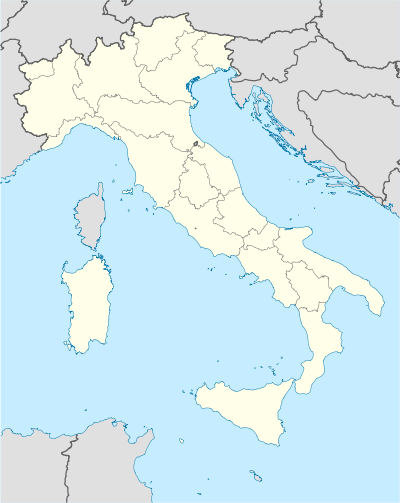Civitavecchia
| Civitavecchia | |||
|---|---|---|---|
| — Comune — | |||
| Comune di Civitavecchia | |||
 |
|||
|
|||
 Civitavecchia
|
|||
| Coordinates: | |||
| Country | Italy | ||
| Region | Lazio | ||
| Province | Rome | ||
| Frazioni | Aurelia, La Scaglia | ||
| Government | |||
| - Mayor | Giovanni Moscherini | ||
| Area | |||
| - Total | 71.95 km2 (27.8 sq mi) | ||
| Elevation | 4 m (13 ft) | ||
| Population (2008) | |||
| - Total | 51,969 | ||
| - Density | 722.3/km2 (1,870.7/sq mi) | ||
| Demonym | Civitavecchiesi | ||
| Time zone | CET (UTC+1) | ||
| - Summer (DST) | CEST (UTC+2) | ||
| Postal code | 00053 | ||
| Dialing code | 0766 | ||
| Patron saint | Saint Fermina | ||
| Saint day | April 28 | ||
| Website | Official website | ||
Civitavecchia is a town and comune of the province of Rome in the central Italian region of Lazio. A sea port on the Tyrrhenian Sea, it is located 80 kilometers west-north-west of Rome, across the Mignone river. The harbor is formed by two moles and a breakwater, on which is a lighthouse.
Civitavecchia means "ancient town".
Contents |
History

The modern city was built over a pre-existing Etruscan settlement.
The harbor was constructed by the Emperor Trajan at the beginning of the 2nd century. The first occurrence of the name Centum Cellae is from a letter by Pliny the Younger (AD 107). The origin of the name is disputed: it has been suggested that it could refer to the centum ("hundred") halls of the villa of the emperor.
In the high Middle Ages, Centumcellae was a Byzantine stronghold. Captured by the Saracens in 828, it was later acquired by the Papal States.
The place became a free port under Pope Innocent XII in 1696. The main port of Rome in modern era, it was occupied by the French in 1849. On April 16, 1859 the Rome and Civitavecchia Rail Road was opened for service. The Papal troops opened the gates of the fortress to the Italian general Nino Bixio in 1870.
During World War II, Civitavecchia was severely damaged by Allied bombings, which caused several civilian casualties.
Economy
Civitavecchia is today a major cruise and ferry port, the main starting point for sea connection from central Italy to Sardinia, Sicily, Malta, Tunis and Barcelona. Fishing has a secondary importance.
The city is also the seat of two thermal power stations. The conversion of one of them to carbon has raised the population's protests, as it has been suggested it could create heavy pollution.
Main sights
- The massive Forte Michelangelo ("Michelangelo's fort") was first commissioned from Bramante by Pope Julius II, to defend the port of Rome, and was completed in 1535 by Giuliano Leno and Antonio da Sangallo the Younger, under Paul III. The upper part of the "maschio" tower, however, was designed by Michelangelo, whose name is generally applied to the fortress. The edifice, measuring 100 × 82 m (328.08 ft × 269.03 ft), has four towers with a diameter of 21 m (68.90 ft). The main tower, of octagonal shape, has sides of 12 m (39.37 ft). The walls have an impressive thickness of 6–7.6 m (19.69–24.93 ft). The fortress was built over an ancient Roman construction, probably the barracks of the classiarii ("mariners") of the Imperial Fleet.
- The Rocca ("castle"), re-built in the late 15th century by Pope Sixtus V. A Palazzo Apostolico was added by Pius IV in the 16th century.
- The cathedral of San Francesco d'Assisi was built by the Franciscans over a pre-existing small church built from 1610. The current edifice, with Baroque-Neoclassical lines, was erected in the eighteenth century.
- North of the city at Ficoncella are the Terme Taurine baths frequented by Romans and still popular with the Civitavecchiesi. The modern name stems from the fig plants among the various pools.
- Next to the town is the location of the cruise ship docks that service all of the Rome area. All major cruise lines start and end their cruises at this location, and many others stop for shore excursion days that allow guests to see Rome and Vatican sights, which are about 90 minutes away.
Geography
Climate
Civitavecchia experiences a Mediterranean climate (Köppen climate classification Csa).
| Climate data for Civitavecchia | |||||||||||||
|---|---|---|---|---|---|---|---|---|---|---|---|---|---|
| Month | Jan | Feb | Mar | Apr | May | Jun | Jul | Aug | Sep | Oct | Nov | Dec | Year |
| Source: [1] | |||||||||||||
International relations
Twin towns and sister cities
Civitavecchia is twinned with:
 Amelia, Italy
Amelia, Italy Bethlehem, Palestinian Authority, (since 2000) [2][3][4]
Bethlehem, Palestinian Authority, (since 2000) [2][3][4] Ishinomaki, Japan
Ishinomaki, Japan Nantong, China
Nantong, China Tivat, Montenegro
Tivat, Montenegro
See also
- Civitavecchia di Arpino exists in the province of Frosinone (Lazio).
References
- ↑ "Civitavecchia historic weather averages in Italy". Intellicast. http://www.intellicast.com/Local/History.aspx?location=ITXX0022. Retrieved 3 June 2009.
- ↑ "Twinning with Palestine". © 1998-2008 The Britain - Palestine Twinning Network. http://www.twinningwithpalestine.net/groupsinternational.html. Retrieved 2008-11-29.
- ↑ The City of Bethlehem has signed a twinning agreements with the following cities Bethlehem Municipality.
- ↑ "::Bethlehem Municipality::". www.bethlehem-city.org. http://www.bethlehem-city.org/Twining.php. Retrieved 2009-10-10.
External links
|
|||||
